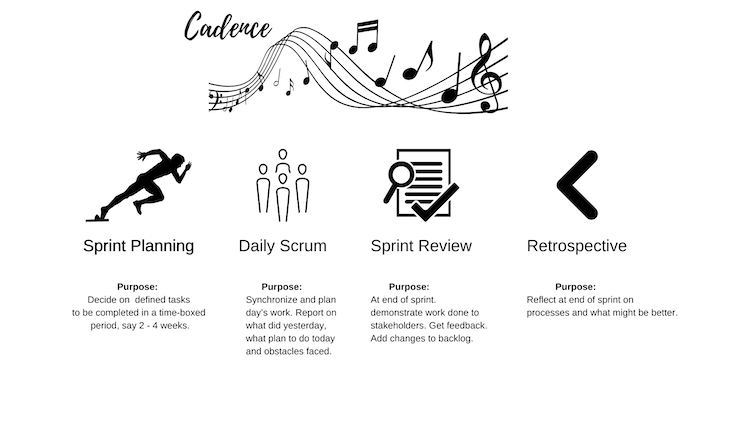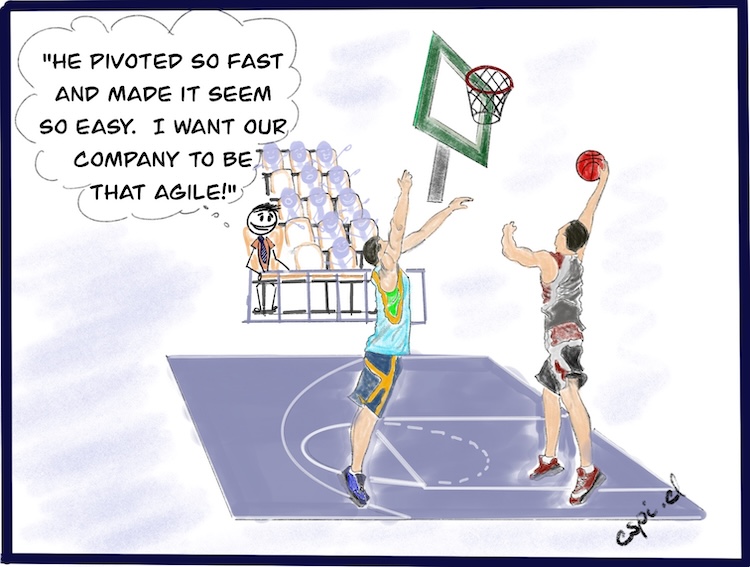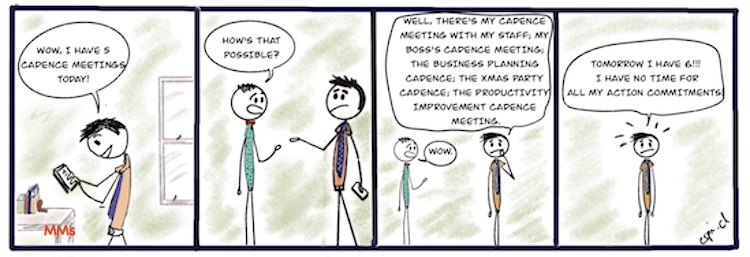The word ‘cadence’ describes a rhythmic sequence of music or words. Popularized for business by the Agile process, it has since become commonplace for managers to have and attend cadence meetings (usually daily or weekly). Cadence meetings are rhythmic in that they happen at the same time and day each period and their purpose is to keep a work flowing smoothly.
In IT Agile systems the meetings have a clear purpose. See the diagram below.

Agile was designed to develop systems quicker and more effectively. Specifically, to avoid doing 6 months of work only to find out the stakeholder is not satisfied with what was developed.
By having short sprints and the Sprint Review the work done gets early feedback from the customer. This feedback, in turn, allows for changes to be made. You could say that the process is agile. The process allows for early adjustments to be made.
Agile has been effective in greatly improving systems development and stakeholder relations.
Enter senior management!
Faced with a constant pressure to do more with less, be innovative and adjust to external changes fast the idea of being an ‘agile organization’ was born.

Agile outside of IT
To apply ‘agile’ to work outside of IT development it is necessary to understand what an agile company means in practice.
Pivot fast, make fast decisions, implement fast, make mistakes and correct fast, be in urgent mode and cut red tape, are a few descriptions of what employees hear when a company asks them to be agile.
You will note that each of these statements are results. Agile itself is a process designed to deliver on these results. It is the process that an agile company needs to implement. It is a way of thinking and working.
Thinking Agile
In essence agile is about breaking work into chunks and testing whether the chunks are delivering what was needed, on time and budget. Agile is best suited to project like work. Namely something that has a distinct beginning and end.
Project management focuses on work packages being delivered on time, on budget and with desired results. Sprints as a concept are the chunks of a work package needing to be completed with in a short timeframe.
Regular work is often repetitive. When some time bound work is required, it can be treated as a project.
How does Agile fit with project and regular work?
1. Work package: Projects are broken down into work packages. The owner of a work package can have cadence meetings to check on the progress achieved and constraints met in getting the work done.
Decisions are made on how to dissolve the constraints and on what work will be done prior to the next cadence meeting. The overall time frame and budget are also considered. The results of the work package can be reviewed to ensure that they meet the requirements of the customer. If not, decisions are made on any adjustments needed. This is similar to agile for systems development.
2. Project Level: At this level the project manager’s cadence meetings have, as their purpose, reviewing the rate at which work packages are progressing. Constraints are identified. Especially those on the critical path. Actions to be taken are discussed with view to completing on time and budget and at a level of desired quality.
3. Regular work: Work that is repetitive is generally measured in terms of throughput, errors constraints. Mostly SLA’s are the stand-in for customer feedback.
Managers use ‘huddles’ for the purpose of checking in and decision making. Huddles are also used for information sharing. The purpose of these huddles tend to focus on immediate constraints or issues. The picture is one of people in a department standing together (or appearing on a ZOOM call)and are short, regular meetings. Mostly held in the morning before the day’s work begins.
These huddles contain elements of the agile huddles but not the sprints.
Working Agile
Sprints are the basis for agile.
A cadence meeting is a regularly scheduled meeting to check progress and results and make adjustments to work to be done in next ‘sprint’. A sprint in athletics is a short, fast race. The fast part of a sprint in agile is achieved through focus on actions, review of results and making required changes or deciding on the resolution of constraints. This focus maintains momentum to completing and achieving the overall result.
The frequency of a cadence meeting depends on the work being done. It might be weekly, every two weeks or even longer.
I roughly divide a cadence meeting into three sections:
a. What did we achieve?
b. Constraints
c. Plan for next period.
What did we achieve? Avoid the mistake of this step taking too long! Most cadence meetings in companies spend too much time in having each participant explain exactly what they have completed. The purpose of the cadence is to keep things moving ahead, therefore, constraints to forward movement are more important than how far you have come. I like to have each person say, when it is true, “I completed what I was tasked to do and the results are acceptable”. If they have a constraint then they will advise “I have completed X but have run into a constraint. The constraint is Y.” or, “ I was not able to complete the work. I will …(actions to bring back on track).’
Constraints. A constraint is anything that is negatively affecting forward movement. If you pinch a hose pipe you constrain the forward movement of water through the pipe.
If a permit has been denied or missed, that is a constraint to forwarding the building on a site.
The person with the constraint might have already taken action to resolve it. In that case no further discussion is needed on the constraint itself. If the constraint acts as a constraint on another participant in the cadence meeting that is raised as a red flag.
If the person who raised the constraint has not resolved it, nor has a plan to resolve it, then the meeting might discuss actions needed.
Customer feedback that requires rework is also a constraint to be reported and handled.
Plan for next period: Each participant shares what they will achieve by the next cadence meeting. Those who raised constraints will include their objective to be achieved in resolving the constraint plus any other results.
Recording Actions and Results.
The cadence meeting will have an action keeper who captures all results anticipated for the next cadence meeting. This is a simple Excel sheet or some app that does the same thing. The sheet will record: Date of cadence meeting. Name of person responsible: Result promised.
At the end of the meeting the action keeper will read through the list to ensure everything was captured and correct.
The action list is distributed or made available on a shared site during or immediately after the meeting. It will be the basis for reporting at the next meeting.
Cadence Impact on urgency and being fast.
Initially the speed factor in Agile was seen in saving time between the development of a requirement, feedback from the customer as to its effectiveness and adjustments needed.
Applying cadence meetings to work in a company, generally, uses focus and rapid constraint naming as its primary tools for being fast.
– Issues are raised in real time and decisions to resolve the issues are handled as fast as possible.
– Participants in the cadence meetings are all doing focused work with a short time frame for results. This, by itself encourages faster turnaround and progress.
– The discipline of listed actions during a brief time period brings the participants together as the reliance on one another becomes apparent. Peer pressure is helpful.
Note that the agile concept does not encourage cutting corners. If a constraint requires further information or study then that becomes an action item. It is the action item discipline that speeds up decision making.
Agile and Innovation or Creativity
Note too that the agile concept can enhance innovation/creativity in two ways:
– Participants can weigh in on resolving constraints. Their ideas might result in elegant or unique solutions.
– Because of the time between meetings, there is a naturally greater appetite to try something out and to get quick feedback on it. This can lead to experimenting with ‘out of the box’ thinking. All invention includes experimentation.
Pivoting
This a word that has also become attached to ‘agile’. Pivot is used to mean “change direction quickly if needed’. It has become popular as an antidote to disruption in market places. The thinking is – as soon as a disruption is recognized the company will pivot to get on the band wagon or find a way to negate the expected damage.
The concept of pivoting – fast change in direction – can be used as part of agile thinking at the level of the work being done. While it might not always be a market disruption, equivalent things can happen to derail a project. Cost overruns, extended time frames, strategy shift, competing crises can all bring a project to a screeching stop.
FINAL IMPORTANT WORDS
Limit the number of cadence meetings.
A regular meeting with staff is not a cadence meeting. The agenda for these meetings can be multi faceted – information giving and sharing being the biggest. Often it is the manager’s way of knowing what is going on and what decisions are needed. Find better ways to keep up to date or share information.
A 3 hour Monday morning meeting is not a cadence meeting. No weekly meeting checkin should take that long. There are better ways to be on top of things.
Restrict cadence meetings to time limited work – that’s why they are designed.
Calling a meeting a cadence meeting because you hold it every week does not make it a cadence meeting in the context of Agile.
A cadence meeting is about progress towards a result and actions needed for the next period.

